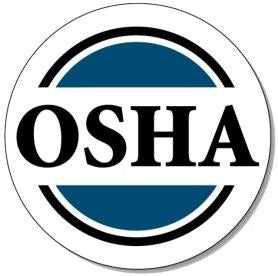September Safety Initiatives to Consider
We hope everyone is having a safe and enjoyable start to the fall. For many employers, the end of summer marks the beginning of an increased production season. It is an important time to make sure your employees understand safety cannot be sacrificed as production increases. Workplace safety should not simply be emphasized during large scale safety initiatives. Workplace safety should be part of the employment culture.
Secretary of State Update
Deputy Assistant Secretary of Labor for OSHA Appointed
President Trump has not yet nominated an assistant secretary of labor for OSHA. Although Tom Galassi remains the acting head of the agency, Loren Sweatt was appointed as the deputy assistant secretary of labor on July 24, 2017. Sweatt previously served the U.S. House of Representatives’ Committee on Education and the Workforce as a senior policy advisor.
As discussed in further detail in the Enforcement and Cooperation section, Secretary Acosta and OSHA continue to indicate an increased willingness to work cooperatively with employers to ensure worker safety.
Regulatory Updates
Silica Enforcement – Points for Trying
OSHA began enforcing the respirable crystalline silica in construction standard September 23, 2017. Last week, however, Galassi instructed his regional administrators to “assist employers who are making good faith efforts to meet the new requirements to assure understanding and compliance.” This enforcement moratorium will last until October 23, 2017. On the other hand, “[i]f, upon inspection, it appears an employer is not making any efforts to comply, OSHA’s inspection will not only include collection of exposure air monitoring . . . , but those employers may also be considered for citation.” Memo from Galassi to Regional Administrators, Launch of Enforcement of the Respirable Crystalline Silica in Construction Standard, 29 CFR § 1926.1153, Sept. 20, 2017.
This instruction marks a continuation of OSHA’s increased focus on cooperation. Employers should, of course, make a good faith effort to comply with the standard during the 30-day period.
Crane Operator Certification Delayed
On August 30, 2017, OSHA published a Notice of Proposed Rulemaking “proposing to delay the deadline and extend the existing employer duty to ensure that operators of equipment covered by this standard are competent to operate the equipment safely for one year to November 17, 2018.” Comments are due by September 29, 2017. Instructions for submitting comments are contained in the notice.
Electronic Recordkeeping Rule – Injury Tracking Application
Last month, OSHA launched the Injury Tracking Application on which employers can submit the information from the 2017 Form 300A Summary of Work-Related Injuries and Illnesses. After briefly shutting down the application due to a potential security breach, it is once again active and can be accessed on OSHA’s website.
The deadline by which certain employers must submit the information from the 2016 300As remains December 1, 2017. The two proceedings challenging to the rule remain administratively closed and stayed; however, both proceedings may resume before the December 1 deadline depending on whether OSHA decides to revise or remove portions of the rule before then.
Employers may submit the information from the 2016 300As at any time between now and December 1, 2017, but employers may wish to consider waiting until closer to the deadline in case OSHA decides to revise or remove all or part of the requirement.
Additional information on the rule and these challenges can be found in our previous posts from May 18 and June 27.
Lockout/Tagout
President Trump’s first regulatory agenda includes a request for information or, alternatively, a stakeholder meeting to explore potential revisions to the lockout/tagout (LOTO) standard to address computer-based controls that have become more prevalent and accepted internationally. This would be a welcome revision for many general industry companies that often must modify equipment from international manufacturers that increasingly implement technologically advanced designs that do not necessarily align with the LOTO standard’s scheme for hazardous energy control.
The agenda marks a notable change by OSHA. Last fall, under the guise of its Standard Improvement Project, the previous administration proposed fundamentally altering the scope and application of the LOTO standard by deleting the term “unexpected” from the standard entirely. 81 Fed. Reg. 68,503. The Standard Improvement Project is currently awaiting issuance as a final rule. The current administration will likely heed many of the comments that were submitted in opposition to this revision. If, however, OSHA ignores the concerns voiced by employers and removes the word “unexpected” from the standard, employers will have to reevaluate their LOTO programs and procedures to account for the change in the standard.
Enforcement Update
Continued Enforcement and Cooperation: Electronic Recordkeeping Rule – Injury Tracking Application
OSHA and its state counterparts continue to actively pursue significant citations against employers. Since August 1, 2017, OSHA has issued seven press releases concerning significant citations with penalties ranging from $95,064 to $1,523,710. The company that received the highest penalty was placed in the Severe Violator Enforcement Program.
While enforcement continues, examples of Secretary Acosta’s emphasis on a more cooperative approach to compliance are increasingly prevalent.
So far in September, OSHA has issued only two press releases concerning enforcement actions compared to five press releases touting successful partnerships and cooperative arrangements.
Earlier this year, OSHA removed from the home page of its website a running list of workplace fatalities. In its place, the website contains “a few examples of our cooperative programs that work with and recognize employers who create safe workplaces.”
OSHA is also “seeking to reshape” its most well-known cooperative program, the Voluntary Protection Program (VPP), “so that it continues to represent safety and health excellence, leverages partner resources, further recognizes the successes of long-term participants, and supports smart program growth.” For the second time this summer, OSHA met with stakeholders August 28, 2017 to discuss possible improvements in overall VPP process and flow, corporate/long-term participant involvement, and special government employee activities.
Lastly, as discussed in the silica update in this issue, OSHA will focus its initial efforts on assisting employers with compliance rather than initiating enforcement actions against companies that are still trying to comply with the new requirements.
As the new administration continues to change the direction of the agency, employers will likely have increased opportunities to work with OSHA on enhanced safety programs. At the same time, significant enforcement will continue. Employers must continue to strengthen and enforce their safety and health programs and culture to protect their employees and their businesses.
Review Comission Update
In a recent decision that became a final order this past summer, Administrative Law Judge Sharon Calhoun vacated a single-item Citation and Notification of Penalty in which OSHA alleged a violation of the safety training and education requirement contained in the construction standards. Sec’y of Labor v. Camarata Masonry Systems, LTD, OSHRC No. 16-0097 (May 26, 2017). The cited standard requires that, “[t]he employer shall instruct each employee in the recognition and avoidance of unsafe conditions and the regulations applicable to his work environment to control or eliminate any hazards or other exposure to illness or injury.” 29 C.F.R. § 1926.21(b)(2).
OSHA alleged that the employer failed to adequately train an employee who was injured when he was unloading a crate with a forklift in a manner that violated the employer’s safety rules. Administrative Law Judge Sharon Calhoun disagreed. Judge Calhoun noted that the standard requires employers to provide the level of instruction that a reasonably prudent person would have provided under the same circumstances. Judge Calhoun further noted that an employee’s training and experience must be taken into consideration in assessing what instructions a reasonably prudent employer in the same circumstances would give. In this case, the injured employee had at least 14 years of experience operating forklifts. A good portion of that tenure was spent performing the exact task he was performing when he was injured. And in fact, the foreman on the project had instructed the injured forklift operator on how to properly unload the crate on the very day of the accident.
Training is an essential part of any well-developed safety program. This decision highlights the importance of providing all employees with proper training on applicable safety and health programs. This decision also highlights the importance of carefully evaluating the factual and legal merit of any citation before accepting it since OSHA can use any accepted citation item, including an Other-Than-Serious citation, as a basis for a Repeat classification for up to five years and Repeat citations now carry a potential penalty of $126,749.




 i
i

